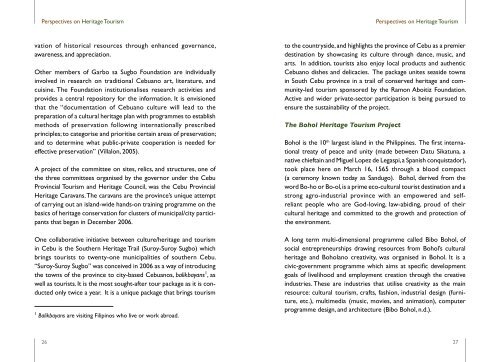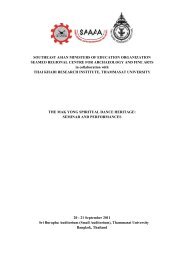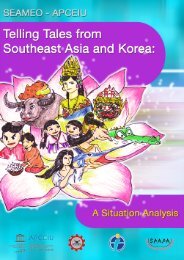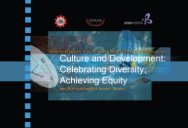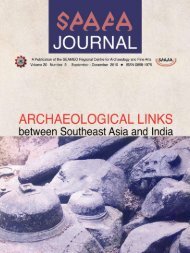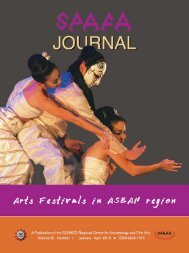Perspectives on Heritage Tourism - Seameo-SPAFA
Perspectives on Heritage Tourism - Seameo-SPAFA
Perspectives on Heritage Tourism - Seameo-SPAFA
You also want an ePaper? Increase the reach of your titles
YUMPU automatically turns print PDFs into web optimized ePapers that Google loves.
<str<strong>on</strong>g>Perspectives</str<strong>on</strong>g> <strong>on</strong> <strong>Heritage</strong> <strong>Tourism</strong><br />
<str<strong>on</strong>g>Perspectives</str<strong>on</strong>g> <strong>on</strong> <strong>Heritage</strong> <strong>Tourism</strong><br />
vati<strong>on</strong> of historical resources through enhanced governance,<br />
awareness, and appreciati<strong>on</strong>.<br />
Other members of Garbo sa Sugbo Foundati<strong>on</strong> are individually<br />
involved in research <strong>on</strong> traditi<strong>on</strong>al Cebuano art, literature, and<br />
cuisine. The Foundati<strong>on</strong> instituti<strong>on</strong>alises research activities and<br />
provides a central repository for the informati<strong>on</strong>. It is envisi<strong>on</strong>ed<br />
that the “documentati<strong>on</strong> of Cebuano culture will lead to the<br />
preparati<strong>on</strong> of a cultural heritage plan with programmes to establish<br />
methods of preservati<strong>on</strong> following internati<strong>on</strong>ally prescribed<br />
principles; to categorise and prioritise certain areas of preservati<strong>on</strong>;<br />
and to determine what public-private cooperati<strong>on</strong> is needed for<br />
effective preservati<strong>on</strong>” (Villal<strong>on</strong>, 2005).<br />
A project of the committee <strong>on</strong> sites, relics, and structures, <strong>on</strong>e of<br />
the three committees organised by the governor under the Cebu<br />
Provincial <strong>Tourism</strong> and <strong>Heritage</strong> Council, was the Cebu Provincial<br />
<strong>Heritage</strong> Caravans. The caravans are the province’s unique attempt<br />
of carrying out an island-wide hands-<strong>on</strong> training programme <strong>on</strong> the<br />
basics of heritage c<strong>on</strong>servati<strong>on</strong> for clusters of municipal/city participants<br />
that began in December 2006.<br />
One collaborative initiative between culture/heritage and tourism<br />
in Cebu is the Southern <strong>Heritage</strong> Trail (Suroy-Suroy Sugbo) which<br />
brings tourists to twenty-<strong>on</strong>e municipalities of southern Cebu.<br />
“Suroy-Suroy Sugbo” was c<strong>on</strong>ceived in 2006 as a way of introducing<br />
the towns of the province to city-based Cebuanos, balikbayans 1 , as<br />
well as tourists. It is the most sought-after tour package as it is c<strong>on</strong>ducted<br />
<strong>on</strong>ly twice a year. It is a unique package that brings tourism<br />
1<br />
Balikbayans are visiting Filipinos who live or work abroad.<br />
to the countryside, and highlights the province of Cebu as a premier<br />
destinati<strong>on</strong> by showcasing its culture through dance, music, and<br />
arts. In additi<strong>on</strong>, tourists also enjoy local products and authentic<br />
Cebuano dishes and delicacies. The package unites seaside towns<br />
in South Cebu province in a trail of c<strong>on</strong>served heritage and community-led<br />
tourism sp<strong>on</strong>sored by the Ram<strong>on</strong> Aboitiz Foundati<strong>on</strong>.<br />
Active and wider private-sector participati<strong>on</strong> is being pursued to<br />
ensure the sustainability of the project.<br />
The Bohol <strong>Heritage</strong> <strong>Tourism</strong> Project<br />
Bohol is the 10 th largest island in the Philippines. The first internati<strong>on</strong>al<br />
treaty of peace and unity (made between Datu Sikatuna, a<br />
native chieftain and Miguel Lopez de Legaspi, a Spanish c<strong>on</strong>quistador),<br />
took place here <strong>on</strong> March 16, 1565 through a blood compact<br />
(a cerem<strong>on</strong>y known today as Sandugo). Bohol, derived from the<br />
word Bo-ho or Bo-ol, is a prime eco-cultural tourist destinati<strong>on</strong> and a<br />
str<strong>on</strong>g agro-industrial province with an empowered and selfreliant<br />
people who are God-loving, law-abiding, proud of their<br />
cultural heritage and committed to the growth and protecti<strong>on</strong> of<br />
the envir<strong>on</strong>ment.<br />
A l<strong>on</strong>g term multi-dimensi<strong>on</strong>al programme called Bibo Bohol, of<br />
social entrepreneurships drawing resources from Bohol’s cultural<br />
heritage and Boholano creativity, was organised in Bohol. It is a<br />
civic-government programme which aims at specific development<br />
goals of livelihood and employment creati<strong>on</strong> through the creative<br />
industries. These are industries that utilise creativity as the main<br />
resource: cultural tourism, crafts, fashi<strong>on</strong>, industrial design (furniture,<br />
etc.), multimedia (music, movies, and animati<strong>on</strong>), computer<br />
programme design, and architecture (Bibo Bohol, n.d.).<br />
26<br />
27


